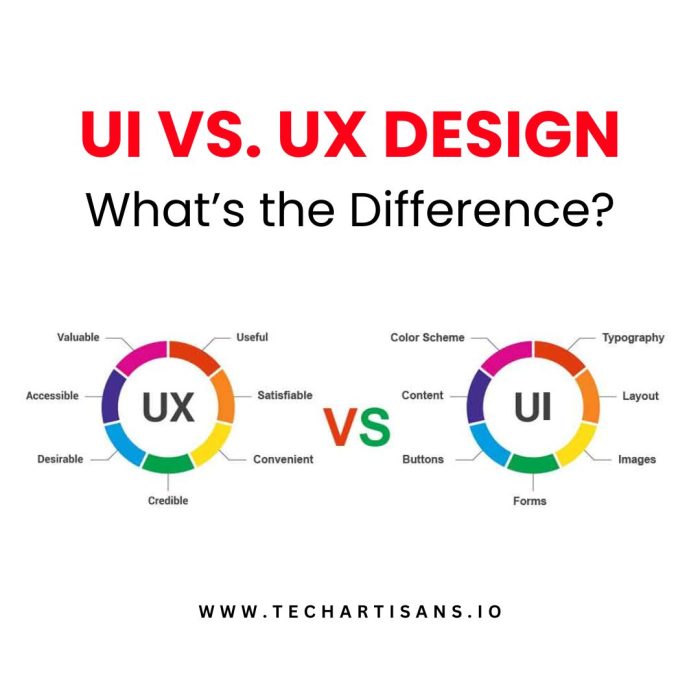Even though both user experience (UX) and user interface (UI) come under the same umbrella in web design, these terms are frequently used interchangeably despite their different definitions and purposes. For newbie designers, understanding the difference between them is the key to establishing general web development knowledge, developing skills, and breaking into the UX/UI design field.
In this article, I will discuss the differences between UX Design and User Interface (UI) Design at length and what is the job of a designer.
What is a User Experience (UX) Design?

User experiences are the user’s journey when they use your product or service. It is a process of providing meaningful experiences to users of your products or services. UX involves several different areas of product development such as usability, design, functions, and branding.
You can think of UX design as the entire process a user goes through when he interacts with a product or service. How does a user come across your service or product; through blogs, advertising, or something else? What kind of human computer interaction does he have with the brand and how he feels about it? These and many more are the major considerations within UX design.
A UX designer’s main goal is to create interfaces that ensure each user has a positive interaction with a product or service. Whether they find your product or service helpful, does it solve their problem, helps them find critical information, provide entertainment, or leave the user feeling fulfilled?
What is a User Interface Design?

UI design is the actual interface with which users engage. The process of UI design includes creating buttons, widgets, images, text, sliders, and other interactive elements for user interfaces. A UI designer’s primary goal is to ensure that every graphic design, animation, and transition in a product or service provides a positive experience for the users.
The Differences Between UX and UI Design

UX and UI designers work closely together so it’s common to confuse UX and UI design with one another. They work with different components of the design of a product or service. Sometimes their roles overlap but here are a few key differences between them:
1. UX Design
a) Feel
The feel of using the product or service
b) High-level
Ensures an easy and consistent flow for the users
c) Prototyping
Creates testable prototypes and wireframes that are the base of a user flow
2. UI Design
a) Look
The look and function of the product’s other visual elements
b) Details
Works on individual elements; buttons, pages, texts, images, etc, ensuring they are functional and updated
c) Design
Finalizes the design of the product for user engagement
3. Feel vs. Look
The roles of UX and UI are related but different in a product’s development. UX design focuses on the overall feel of the product or service. It works on the components that lead to a meaningful, relevant experience for users. On the other hand, UI design deals with the look of a product; the visual and interactive elements that gives a positive user experience.
4. Prototyping vs. Design
UX designers create testable prototypes and wireframes that is the basis of user flow when they use the product or service. Meanwhile, a UI designer works on the visual design elements of the product to drive user engagement.
5. Details vs. High-Level
UI designers create individual components; buttons, pages, and interactions. They make sure these components are functional and polished. On the other hand, UX designers ensure visual interface elements of the site or mobile apps provide a consistent collective user flow.
How do UX and UI Designers Work Together?

UI and UX designers have different responsibilities but both make up the entire usability design process of a website. They are complementary contributors to a positive, intuitive user journey.
A website’s UX elements; feel and client-facing messaging are built on top of the UI design; technical structure and aesthetic. Both professions work in coordination to benefit the overall product or service to provide a positive impression on users.
Major Responsibilities of UX Professionals
Mainly, a UX designer maps development strategy, implementation, testing, and analysis of the overall design and performance of the product or service. Here are some of the major responsibilities of a UX designer.
UX designers play a vital role in optimizing user journeys. Learn how to ensure your website attracts the right leads.
1. Content Strategy Development:
UX designers focus on the planning, creation, and execution of content. The content can be in the form of text, images, and videos on a website page. Developing a content strategy is not the main responsibility of a UX designer but many companies emphasize content-driven design for a more effective user experience design.
Tasks for developing a content strategy may include:
- Content mapping and auditing
- Customer analysis
- Competitor analysis
2. Testing
Prototyping and testing are some of the most important parts of the UX design process. Designs go through several tests before they are finalized and approved.
The main tasks for testing designs include:
- Wireframing the basic structure of designs
- A/B testing between text layouts, button placements, and other design elements
- Prototyping designs to text for function
3. User Research
The best UX designs require a lot of research on different problems and their solutions with a specific design. UX research may involve surveys, questionnaires, product testing, or research methodologies based on the goal of the design.
For example, quantitative data from questionnaires and surveys will show how users utilize a new feature, while qualitative data can show how users feel about the design of the product or service. Conducting the right research helps redesign a product or service according to the needs of the target users which has a huge impact on the product’s performance.
Common tasks for consumer research may include:
- Adopting and designing the right research methodology
- Conducting research through questionnaires, focus groups, surveys, etc.
- Analyzing data gathered from the research.
4. Coordination and Analysis
UX designers work closely with a broader design team to plan, develop strategy, execute, and analyze projects’ performance after implementation.
Common tasks related to coordination and analysis include:
- Planning for future projects
- Analyzing existing designs
- Tracking the performance of designs
Major Responsibilities of a UI Designer

UI designers often work with popular platforms like WordPress. Discover the benefits of using WordPress for your website.
A UI designer focuses on the specifics of the graphical user interface of a product or service. They choose fonts, create visual elements, and make pages and other individual components visually appealing to meet the product’s objectives. They oversee the overall style and functionality of the design.
1. Create and Maintain Brand Style
UI designers establish a defined brand style which is crucial for most businesses these days. This is an important component in the UI design process from a usability standpoint. Their main goal is to make sure the product or service’s design is aesthetically consistent with the brand’s theme and goal.
Creating and maintaining brand style may include tasks like:
- Create brand style guides
- Implementing a brand’s style consistently across a product or service
- Maintain accessible design standards
2. Create Visual Design
UI designers build and optimize the individual components of the product including color, typography, buttons, and other elements that help in a strong interface.
Building visual design may include tasks such as:
- Coloring elements of a website or service
- Designing buttons and other clickable elements
- Choosing fonts and typesetting
3. Create Interaction Design
UI designers often develop and implement the interactive components of a product or service which may include animations, images, pictures, etc. to make users take a certain action.
Tasks for creating an interactive design may include:
- Creating animations
- Developing interactive elements like photos or videos
- Managing how content reacts when the users interact with it
4. Developing Responsive Design
Products or services have to be made responsive to make them accessible across a wide range of devices such as desktops, laptops, smartphones, and tablets. Responsiveness is especially important for web designing so the websites are usable on every screen.
Tasks to make responsive design may include:
- Developing easily resizable vector elements
- Making flexible website or program layouts
- Developing responsive design style guides
Why UX and UI are important?
Combining UX, UI, and SEO is essential for online success. Explore the benefits of responsive web design for SEO.
UX and UI are complementary roles and are naturally related to one another. With a knowledge of both, professionals of either discipline can contribute to a more cohesive design process that gives a better final product.
Also, UX design skills are high in demand these days and a strong understanding of both UX and UI design will be beneficial for those looking to capitalize on this growing demand.













